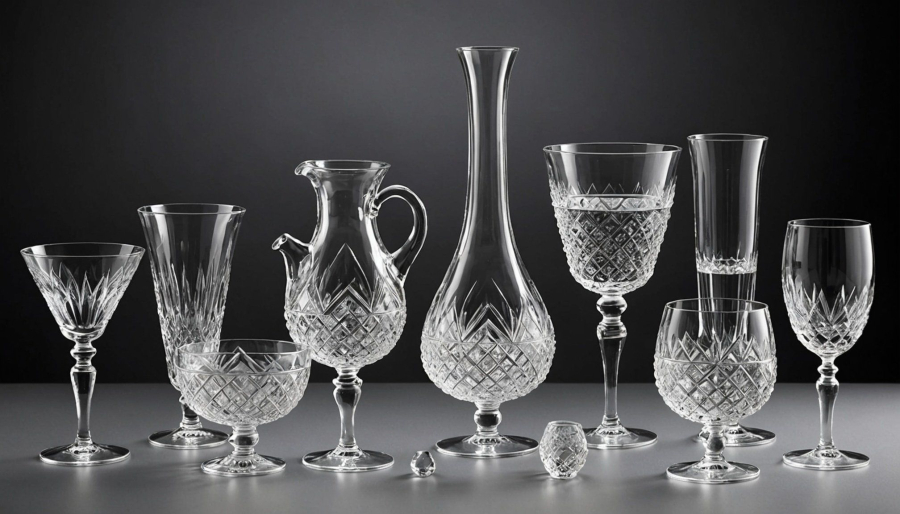Choosing the right crystal glassware transforms every experience—from casual dinners to celebratory toasts. Discerning the differences between types ensures your settings impress and your beverages shine. Whether you collect, entertain, or simply appreciate quality craftsmanship, understanding key features, materials, and care tips helps you invest wisely. Explore what sets true crystal apart and discover the perfect piece for every occasion.
Essential guide to crystal glassware : types, characteristics, and comparisons
With unmatched brilliance and a storied history, crystal glassware stands apart from everyday glass through its unique composition and craftsmanship. While regular glass contains silica, soda, and lime, crystal is enhanced by the addition of lead oxide or alternative metal oxides. This extra element delivers exceptional clarity, sparkle, and a delightful ring when tapped—traits prized by collectors and enthusiasts alike.
Key differences emerge in weight, sound, and refraction. Crystal pieces feel heavier and more refined, with thin, precise rims—a sharp contrast to the robustness of typical glassware. Lead crystal, traditionally containing at least 24% lead oxide, boasts superior brilliance and detailed cut patterns, whereas lead-free variations use modern compounds for safer use without sacrificing clarity.
Historically, European artisans elevated the production of crystal in the 17th century, and today’s innovation includes machine-cut, hand-blown, and designer editions. Spotting authentic crystal involves evaluating clarity, weight, tone, and intricate patterns; imitation pieces often lack these hallmarks. Distinguishing crystal from glass ensures enduring appeal and value in any collection.

Major types and styles of crystal glassware
Crystal glassware types are shaped by both their material and production methods. Pressed, cut, hand-blown, and machine-made techniques result in distinct forms and aesthetics. Hand-blown crystal glasses stand out for their thinness and balance, a feature rarely achieved by machine production. Pressed crystal glassware types tend to be heavier, with more durable, uniform surfaces.
Vintage crystal glassware, often sought by collectors, features elaborate cut crystal patterns and regional craftsmanship influences. Recognizable motifs in vintage crystal glassware—like starbursts, fans, or diamonds—signal particular origins and eras. Cut crystal patterns add texture and brilliance, enhancing both the tactile feel and appearance of each piece.
Among the crystal wine glasses varieties, bowl shape impacts how aromas and flavors develop. In contrast, different champagne flutes styles are designed to preserve bubbles and showcase sparkling clarity. Crystal whiskey glasses types, including short tumblers for whiskey, emphasize comfort and heft, crucial for appreciating aroma and temperature.
Crystal decanters guide collectors toward styles that combine functionality and design. Each form—whether for oxygenating wine or presenting spirits—reflects ongoing traditions in crystal glassware types, style, and cut crystal patterns.
How to choose, identify, and buy quality crystal glassware
Selecting standout crystal glassware starts with recognizing clarity, craftsmanship, weight, and cut. Authentic crystal glassware feels noticeably heavier due to its structure. Examine the crystal clarity and brilliance—light should refract impressively, signaling quality. Superior pieces will show intricate, sharp crystal cuts and perfectly finished rims.
When conducting a crystal glassware brands comparison, consider the best crystal brands that balance tradition with modern design. Certain brands have mastered distinctive cutting techniques; look for clear trademarks and consistent crystal glassware craftsmanship to confirm legitimacy. Comparing crystal glassware pricing guides helps reveal fair market values and avoid overpriced items.
For enthusiasts hosting parties, searching for crystal glassware for cocktails demands glassware specifically engineered for drink types—think robust tumblers or elongated flutes for sparkling beverages. Those drawn to personalized touches should investigate custom engraved crystal glassware, ideal for gifts or commemorations.
Buyers focused on identifying authentic crystal can tap and listen: a long, resonant ring indicates the presence of crystal. Understanding these signs allows you to invest with confidence, enjoying luxury designs tailored for both daily use and special occasions.
Caring for, maintaining, and restoring crystal glassware
Proper care for crystal glassware begins with gentle, hand-washing using warm water and a mild, non-abrasive detergent. Avoid using abrasive pads or harsh chemicals, as these can scratch or cloud surfaces. For those wondering how to clean crystal glasses, use a soft sponge and rinse thoroughly to maintain clarity and brilliance. Never expose crystal glassware to extreme temperature changes, as this increases the risk of cracking.
For long-term crystal glassware maintenance tips, always dry items with a lint-free cloth. This step is key for maintaining sparkle in crystal glasses, ensuring no water spots remain. To minimize wear, handle only by the bowl, not the stem, and avoid stacking pieces during storage.
Storing crystal glassware properly matters. Place glasses upright in a dust-free cabinet, allowing air circulation around each piece. Care instructions for lead crystal emphasize keeping them away from direct sunlight to prevent fading and loss of luster.
Over time, common maintenance issues—such as dullness or fine scratches—may arise. Crystal glassware polishing with a microfiber cloth can help restore some brilliance. Where deeper restoration is needed, consult a professional to ensure your treasured glassware stays stunning for years.
Latest trends, collectors’ insights, and special considerations
Precision: Modern crystal glassware trends reveal a shift towards clean, angular forms and innovative finishes, prioritizing both beauty and crystal glassware durability. Leading 2024 highlights include frosted effects and striking geometric patterns. These modern crystal glassware trends respond to increasing demand for both everyday use and memorable crystal glassware for entertaining.
Collectors are focusing on pieces with high differences in crystal clarity, rare cuts, and signs of traditional craftsmanship. The market’s growth for vintage sets shows that discerning crystal glassware collectors value exceptional crystal glassware durability alongside aesthetic qualities. Provenance, maker’s marks, and differences in crystal clarity drive valuation, with clear, weighty pieces favored for authenticity.
Today’s hosts often select versatile styles for crystal glassware for special occasions like weddings or anniversaries. Modern designs enhance gatherings, while classic forms endure for formal tables. As luxury crystal glassware gift ideas become more personal, engraving and custom collections are gaining traction, particularly with those seeking unique, lasting keepsakes for significant milestones.
